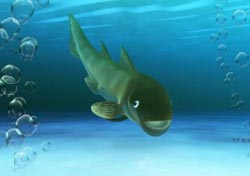A new species of marine fish from 408 million years ago discovered in Teruel

This is Machaeracanthus goujeti.<br>Credit: SINC<br>
In the journal 'Geodiversitas', a research team led by the University of Valencia describes a new species of spiny shark (Acanthodii), a primitive type of fish that shared characteristics with sharks and bony fish.
Remains of scales, bones and scapular joint bones were found in Devonian (approximately 408 million years ago) in Teruel and the south of Zaragoza. The paper also includes an analysis of fossils of a fragmented spine and isolated scales from the Lower Devonian found in northern Spain (Palencia and Cantabrian Mountains) and western France (Saint-Céneré commune), originally attributed to the Machaeracanthus sp species.
“The discovery of this new species, which we call Machaeracanthus goujeti and belongs to the Acanthodii group –of which very little is known–, expands our knowledge of the biodiversity that existed on the peninsula 480 million years ago, when the modern-day region of Teruel was covered by the sea,” Héctor Botella, professor in the palaeontology unit in the University of Valencia and the study's lead author, explained to SINC.
The Acanthodii group of fish are also known as 'spiny sharks' owing to their appearance and, from what we know to date, they only lived during the Palaeozoic Era and reached their maximum level of diversity in the Devonic period.
However, the bones typically found in the Acanthodii group grow differently to the bones found, therefore this type could be even more similar to sharks and would date from the very early stages of the radiation of jawed vertebrates (gnathostomata).
A fish fossil no more than one metre in length
The majority of the samples found by the researchers are juveniles. Based on the fossilised remains, the researchers estimate that the largest fish in this species would not reach one metre in length. “This is just an estimation because there are animals that can have large bones and be small, and vice versa,” Botella stated.
For their part, the fossils found in the sediment layers of the Iberian mountain range must surely have belonged to fish that swam close to the coast. “In other words, they must have lived in an epicontinental sea –an extensive but shallow salt water mass–, and it is therefore possible that this area was used as a breeding ground,” he concludes. Larger fossils were found in sediment layers a little further down.
The fossils form part of the collection housed in the Palaeontology Museum of Zaragoza.
References:
Héctor Botella, Carlos Martínez-Pérez, Rodrigo Soler-Gijón “Machaeracanthus goujeti n. sp. (Acanthodii) from the Lower Devonian of Spain and northwest France, with special reference to spine histology”, Geodiversitas, 34(4):761-783, 2013.
Media Contact
More Information:
http://www.agenciasinc.esAll latest news from the category: Earth Sciences
Earth Sciences (also referred to as Geosciences), which deals with basic issues surrounding our planet, plays a vital role in the area of energy and raw materials supply.
Earth Sciences comprises subjects such as geology, geography, geological informatics, paleontology, mineralogy, petrography, crystallography, geophysics, geodesy, glaciology, cartography, photogrammetry, meteorology and seismology, early-warning systems, earthquake research and polar research.
Newest articles

High-energy-density aqueous battery based on halogen multi-electron transfer
Traditional non-aqueous lithium-ion batteries have a high energy density, but their safety is compromised due to the flammable organic electrolytes they utilize. Aqueous batteries use water as the solvent for…

First-ever combined heart pump and pig kidney transplant
…gives new hope to patient with terminal illness. Surgeons at NYU Langone Health performed the first-ever combined mechanical heart pump and gene-edited pig kidney transplant surgery in a 54-year-old woman…

Biophysics: Testing how well biomarkers work
LMU researchers have developed a method to determine how reliably target proteins can be labeled using super-resolution fluorescence microscopy. Modern microscopy techniques make it possible to examine the inner workings…





















